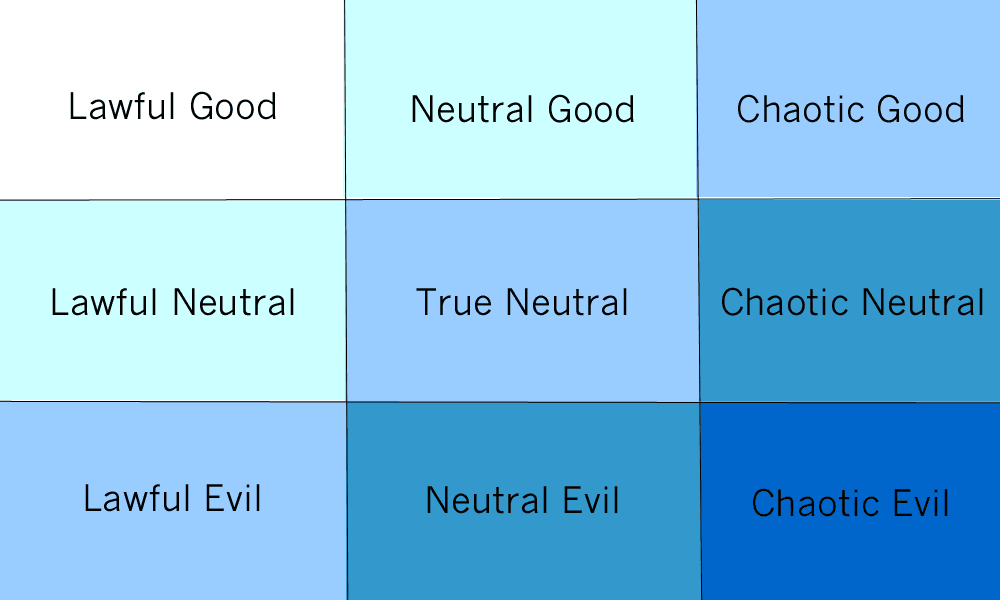The Chart That Explains Everyone
Now that Dungeons & Dragonshas been around since the 1970s, many former players have gone on to become successful novelists, playwrights, screenwriters and video game designers. And, when you ask them, many of those former players say that D&D was a foundation of their creative process. And they often point to an exercise in the game that helps them create complex fictional characters.
When you create a character in D&D, you decide where to put that character on a moral axis. Are you good, evil, or morally neutral? Simple enough. But then you have to decide where your character fits on a law-abiding axis. Do you always obey the law? Are you neutral about the law? Or are you chaotic — do you believe laws are meant to be broken?
The best way to wrap your head around this concept is to imagine a grid, like “Hollywood Squares” or the opening credits of “The Brady Bunch” — nine squares in total, three on each side and one in the middle. The square in the upper left hand corner is “lawful good.” Think of Superman — the Boy Scout who cares as much about saving the planet as he does from saving a cat from of a tree.The next square over on the top row is “neutral good.” In the world of “Star Trek,”Spock is lawful good but Captain Kirk is neutral good, because he is willing to break the rules if he thinks they’re preventing him from doing as much good as possible.But Kirk is still part of the system, the Federation Starfleet. If go you to the last square on the right — “chaotic good” — you get someone like Robin Hood, who can never be tied down to any organization. He thinks the only way to do good in the world is to upend the social order.
In the middle row are morally neutral characters. “Lawful neutral” would be a mindless bureaucrat, or a brutal enforcer like Javert from “Les Miserables”who hunts down the heroic ex-con Jean Valjean.”True neutral,” in the center square, is a character like the Oracle in “The Matrix,” who accumulates wisdom from witnessing everything but rarely takes a side.The far right square in the middle row is a really fun character: “chaotic neutral.” That’s “someone who can be swayed based on who has the power,” explains the writer and graphic novelistSam Sattin.A good example would be Omar from“The Wire”— the lone wolf who robs drug dealers, valuing his freedom and his survival equally.
Finally in the bottom row: the three types of evil. First, there’s “lawful evil.” “Napoleon from “Animal Farm” is actually one of the ones I was thinking of,” says Sattin. “They create an entire order, they create a law, they create a system — then they use that system to destroy anyone who dissents.”The next square over is “neutral evil.” Think of Voldemort from the “Harry Potter” series. A lawful evil character would want to take over Hogwarts or the Ministry of Magic, but Voldemort would rather topple them and create his own brutal order. Finally, the last square on the bottom right-hand corner is “chaotic evil.” That’s more like the Joker, as portrayed by Heath Ledger in “The Dark Knight.”
When Sattin teaches writing seminars, he asks his students to figure out where their characters fit on this grid, and he encourages them to create characters who are conflicted — they wish they were one alignment, but really they’re something else.Storytelling really takes off when characters of different alignments play off each other.”The most important part of writing is the way in which characters interact with each other,” he says.
These alignments play out in the real world as well. Patrick O’Connor is a sci-fi and fantasy fan. He’s also an assistant district attorney who prosecutes gang-related homicides in Brooklyn. He imagines the gang members he prosecutes could be categorized as neutral evil on the character alignment spectrum.
In his own life,O’Connor always tries to follow the straight and narrow path. Does that mean he’s drawn to lawful good characters in comic books? “No, because that’s boring,” O’Connor says. “I like having the lines blurred.” His favorite character is Punisher, the Marvel vigilante who kills criminals because he doesn’t believe in the legal system.
The history of comics has been filled with battles between good and evil, but now we’re more interested in watching characters on the same side fight each other. This year, on season two of “Daredevil”on Netflix, and in the movies “Batman v. Superman”and “Captain America: Civil War,”superheroes duke it out. Each of these stories is about a conflict between personal ethics and the law. “That’s how a lot of people feel, that they have these government forces they can’t control, that are doing nefarious things,” says O’Connor. “They feel marginalized, and they feel they can’t trust system. And so they take things into their own hands.”
Michael LaBossiereteaches philosophy at Florida A&M University, and he takes a more holistic approach. He argues that each of us can embody the different character alignments at any point in our lives. It all depends on the situation. “Sometimes we’re more good, sometimes we’re more neutral, or in some situations we fall into bad behavior,” he says. “A person can be decent but have those neutral evil moments when they’re selfish and take that last piece of pie.”
LaBossiere says we often judge people in history for being complacent about the great injustices in their time — like slavery. We want our historical figures to be chaotic good, to have the guts to upend the social order and always do the right thing.His response: “There’s a lot of evil today. Put on your cape and go to it.”
A version of this story originally ran on Imaginary Worlds.
